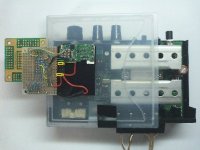EUVL said:With all respect, I think you are making it more complicated than necessary. Other than the designs from Koon and ECDesign, there are many examples of SD Card Wave Players which all look very minimalistic, e.g.
http://www.omniboard.be/
(The Echo 2 will play WAV as well as MP3, I was told).
One thing in common -- they all use some versions of dsPIC33 family.
Maybe dsPIC33 is the right choice for the purpose ....
Patrick
This one uses VLSI chips, too! The main difference is the µC and playback is done through the in-built DAC of the VS10xx-chip and not with high-quality DAC like WM8741!
Tolu said:This one uses VLSI chips, too! The main difference is the µC and playback is done through the in-built DAC of the VS10xx-chip and not with high-quality DAC like WM8741!
I was surprised with a good sound from native DAC of VS1053b when I listened to it for the first time. Clear and powerful.
It's true that external DAC chips does not give necessarily good results.
Though Patrick seems to concern the complexity in the chip, I think the precision of LRCLK pulse interval is very good. When I observed it using a 2GHz spectrum analyser, no remarkable phase noise nor characteristic spurious was found.
Bunpei
Bunpei said:
Now, we can output to generic DACs of S/PDIF input.
Recently an audiophile whose favorite music category is Classic, evaluated our VS1053b Proto Board version using S/PDIF and his high-class DAC and amplifier.
His comment is "This SD Memory Card transport sounds like a sound reproduced by analog equipment." The term, analog equipment, means a combination of LP record, LP record player, and pre-amplifier. He said his comment meant "It's a good sound, admirable."
Bunpei
Chiaki and Bunpei tried to connect their MicroSD transport to a Japanese Class-D Amplifier, RSDA-302U, a product of Rasteme Systems Co., Ltd by modifying the PCB of the amp.
The amplifier is so-called "full-digital" and uses STA 328 Class-D Amplifier chip, incorporating TI PCM2706 for USB input and Cirrus Logic CS5340 for analog line input. The amp employs I2S as its internal common audio signal path. We removed the CS5340 and a crystal for the ADC chip and connected I2S lines fo the MicroSD transport instead. Fs is 48kHz and data bit length is 16bit under this condition. MCLK is 12.288MHz.
On this amplifier product, a microcontroller, MSP430F133, sets necessary dynamic register values of STA 328 via I2C for enabling digitally implemented volume, treble, bass control functionality bulit in STA 328. As we could not hack the firmware of the MPU, an additional effort for changing BCLK signal frequency from 1.536MHz to 3.072MHz was necessary so as to maintain a compatibility with the original ADC chip. For this purpose, Chiaki added a CPLD.
Bunpei compared sounds of two different audio sources, USB and MicroSD transport and favored MicroSD transport more because it reproduces more details than USB. This result may be due to the effect of TCXO used in the MicroSD transport.
Bunpei
The amplifier is so-called "full-digital" and uses STA 328 Class-D Amplifier chip, incorporating TI PCM2706 for USB input and Cirrus Logic CS5340 for analog line input. The amp employs I2S as its internal common audio signal path. We removed the CS5340 and a crystal for the ADC chip and connected I2S lines fo the MicroSD transport instead. Fs is 48kHz and data bit length is 16bit under this condition. MCLK is 12.288MHz.
On this amplifier product, a microcontroller, MSP430F133, sets necessary dynamic register values of STA 328 via I2C for enabling digitally implemented volume, treble, bass control functionality bulit in STA 328. As we could not hack the firmware of the MPU, an additional effort for changing BCLK signal frequency from 1.536MHz to 3.072MHz was necessary so as to maintain a compatibility with the original ADC chip. For this purpose, Chiaki added a CPLD.
Bunpei compared sounds of two different audio sources, USB and MicroSD transport and favored MicroSD transport more because it reproduces more details than USB. This result may be due to the effect of TCXO used in the MicroSD transport.
Bunpei
Attachments
Bunpei said:
Chiaki and I are making a concept for the next step. My requirement is 24bit 192KHz I2S output.
Chiaki has almost completed making his new prototype board (in the left side of the following picture) for playing 24bit 192kHz WAV files. Though Bunpei has not listened to its output sounds yet, he expects a good result.
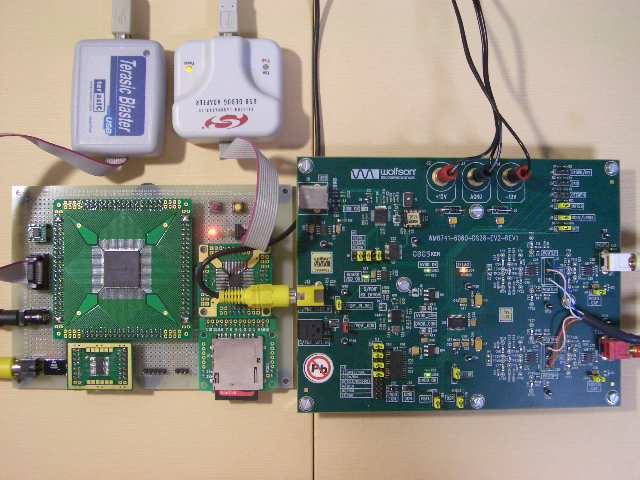
The new board has quite a different architecutre.
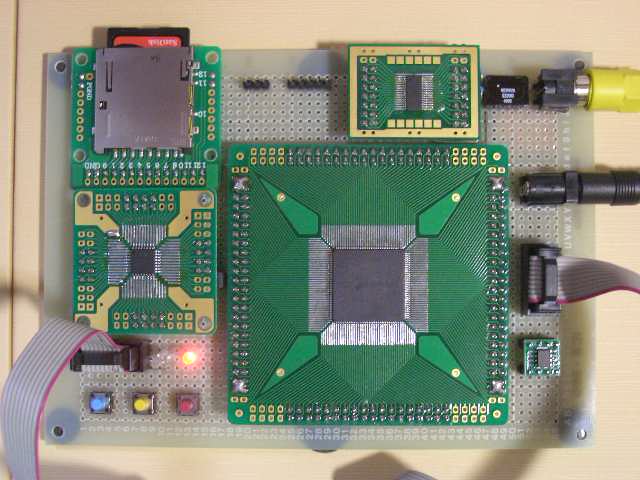
A. SD memory card slot is adapted instead of MicroSD memory card
B. SDHC memory card can be used
C. FAT32 readable ( in progress )
D. RIFF WAV files of 8/16/24/32 bit, mono/stereo, 32/44.1/48/88.2
96/176.4/192kHz are supported (however, no FLAC, MP3, WMA, AAC)
E. Both I2S and S/PDIF (RCA) output.
F. User interface with three button and one LED (no LCD display)
No VS1053b chip is incorporated in this version. For PCM to I2S conversion, FPGA Altera Cyclone III(EP3C25E144)[The biggest chip in the picture above] is employed.
A microcontroller is Silicon Laboratories C8051F361 (100MIPS 8051 architecture machine of 100MHz clock). It reads WAV PCM data from SDHC memory card.
For S/PDIF output, Cirrus Logic CS8406 is used with a pluse transformer, Newava Technologies S22083.
As soon as Bunpei confirms its sound, a new report will be posted here.
Bunpei
In terms of high-precision clocking, Chiaki implemented the following mechanisms in the design.
1. Two separate TCXOs, 22.5792MHz for 44.1kHz x n and 24.576MHz for 48kHz x n, are employed.
2. Two master clocks (MCLK for I2S) are from the TCXOs.
3. I2S relevant clocks, LRCLK and BCLK, are derived from the master clock by simple scalers formed in the FPGA.
4. PCM to I2S conversion is achieved in a dual clocked FIFO in the FPGA. I2S output side runs exactly synchronizing to the master clocks described above. It's independent to PCM input side clocking.
5. I2S signals are synchronized again at the last stage in the FPGA.
As a result, the intervals of I2S siginals are to be very independent to activities of the microcontroller side.
However, we have measured neither phase shift noise nor Allan Variance of I2S signals yet. Therefore, we have no objective evidence for a "low jitter" profile of this equipment so far.
Bunpei
1. Two separate TCXOs, 22.5792MHz for 44.1kHz x n and 24.576MHz for 48kHz x n, are employed.
2. Two master clocks (MCLK for I2S) are from the TCXOs.
3. I2S relevant clocks, LRCLK and BCLK, are derived from the master clock by simple scalers formed in the FPGA.
4. PCM to I2S conversion is achieved in a dual clocked FIFO in the FPGA. I2S output side runs exactly synchronizing to the master clocks described above. It's independent to PCM input side clocking.
5. I2S signals are synchronized again at the last stage in the FPGA.
As a result, the intervals of I2S siginals are to be very independent to activities of the microcontroller side.
However, we have measured neither phase shift noise nor Allan Variance of I2S signals yet. Therefore, we have no objective evidence for a "low jitter" profile of this equipment so far.
Bunpei
Bunpei said:As soon as Bunpei confirms its sound, a new report will be posted here.
Today, Bunpei received the 192kHz 24bit WAV file compatible, SDHC Memory Card Transport from Chiaki.
Chiaki is publishing his achievement on his web page (in Japanese).
http://www.chiaki.cc/Transport/sdtrans192.html
New pictures are available on his web page.
<Connected to WM8741 Evaluation board>
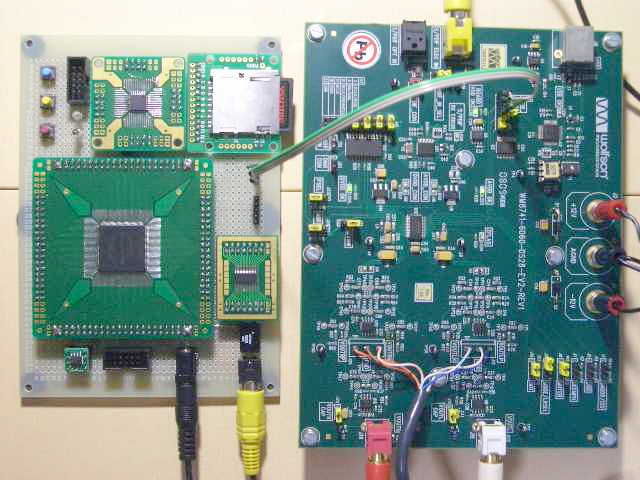
In this picture, S/PDIF is used, instead of I2S.
<Solder surface>
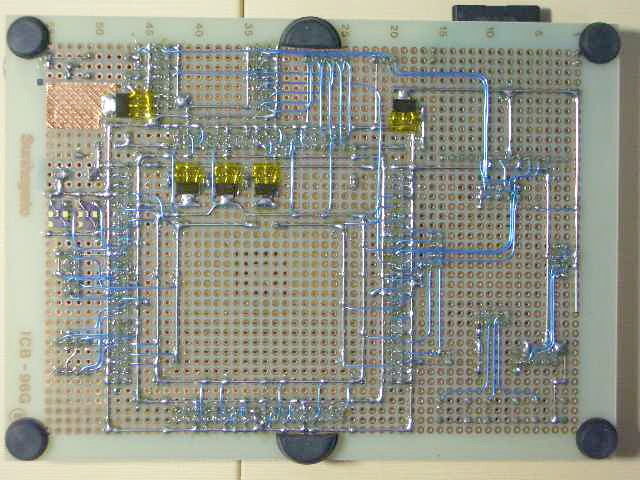
You can see 5 black power regulators and two TCXOs( two light purple rectangular components along the left margin).
Bunpei listened 192kHz 24bit sources obtained from
Hires 2L: http://www.2l.no/hires/index.html
and
Lin Records: http://www.linnrecords.com/catalogue.aspx?format=high&sort=releasedate&order=desc
using Etymotic ER-4S earphones connected to WM8741 Evaluation board employing an I2S interfacing method.
His primary impression is "sounds are more smooth, fine and continuous than that of 48kHz 16bit down-sampled ones" and "less-digital taste".
Strings in orchestra are resolved well enough to enjoy them.
Chiaki is planning to design and release a new PCB board kit with necessary components. Please let us know your opinions.
bunpei<at>ta2<dot>so-net<dot>ne<dot>jp
(The improved version may have a simple LCD display.)
Bunpei thinks this kind of players including ecdesigns' one are much worth trying and listening.
Bunpei
Dear Bunpei,
have You tried to play wolfson board through USB?
Ive finally made my DAC, but Windows doesn't recognize any new hardware (tas1020b). When i plug in the usb cable i hear the specific sound in windows, but nothing apears, theres no new usb controler installed.
Does it need any drivers? Could You help me Bunpei?
have You tried to play wolfson board through USB?
Ive finally made my DAC, but Windows doesn't recognize any new hardware (tas1020b). When i plug in the usb cable i hear the specific sound in windows, but nothing apears, theres no new usb controler installed.
Does it need any drivers? Could You help me Bunpei?
prinzinio said:have You tried to play wolfson board through USB?
Ive finally made my DAC, but Windows doesn't recognize any new hardware (tas1020b). When i plug in the usb cable i hear the specific sound in windows, but nothing apears, theres no new usb controler installed.
Does it need any drivers? Could You help me Bunpei?
Dear prinzinio,
I'm afraid that you have misunderstood functionality of the USB interface provided on WM8741 Evaluation Board. It can be used only for setting registers in WM8741 chip via I2C interface. It's not designed for audio interface for PC. The USB communication is established when we run proprietary utility software downloaded from Wolfson's web site. No standard USB audio drivers support the hardware.
If you want to output audio signals from your PC to the evaluation board, you need to employ one of S/PDIF (RCA) interfaces; USB-based, Firewire-based, or PCI-based.
Bunpei
thank You for the answer.
I've called the Wolfson technical support today and they've told me exactly same thing as You said.
Yes, i've missunderstood the USB funcionality of WM8741 EVB.
But i have to admit that its quite sad...
tas1020b is one of the best usb controller ever, used mainly in the most expensive audio equipment.
Wolfson had opportunity to use it as a audio stream controller, but they didnt ;(.
Maudio Transit is made on Tas1020b chip, but their drivers does not recognize the wolfson tas1020b..
I've called the Wolfson technical support today and they've told me exactly same thing as You said.
Yes, i've missunderstood the USB funcionality of WM8741 EVB.
But i have to admit that its quite sad...
tas1020b is one of the best usb controller ever, used mainly in the most expensive audio equipment.
Wolfson had opportunity to use it as a audio stream controller, but they didnt ;(.
Maudio Transit is made on Tas1020b chip, but their drivers does not recognize the wolfson tas1020b..
prinzinio said:Maudio Transit is made on Tas1020b chip, but their drivers does not recognize the wolfson tas1020b..
If you stick to using USB, a Chinese less expensive USB Interface unit is available via eBay.
http://cgi.ebay.com/2009-MUSILAND-Monitor-01-USD-HI-FI-Mini-USB-sound-card_W0QQitemZ110390560547
It supports 192kHz 24bit by way of dedicated ASIO driver. However, I will hesitate to recommend this if you expect high quality that matches the WM8741 evaluation board.
Bunpei
prinzinio said:thank You for the answer.
I've called the Wolfson technical support today and they've told me exactly same thing as You said.
Yes, i've missunderstood the USB funcionality of WM8741 EVB.
But i have to admit that its quite sad...
tas1020b is one of the best usb controller ever, used mainly in the most expensive audio equipment.
Wolfson had opportunity to use it as a audio stream controller, but they didnt ;(.
Maudio Transit is made on Tas1020b chip, but their drivers does not recognize the wolfson tas1020b..
Bunpei said:The USB communication is established when we run proprietary utility software downloaded from Wolfson's web site. [/B]
prinzinio,
I think you need to download the software for the WM8741 eval board from here: http://www.wolfsonmicro.com/driversLicensePage.action?id=12491&evalBoardId=148
To extract this software requires something call WISCESetup.exe from Wolfson Applications support. I presume this then gives you the firmware which you need to write to the eeprom chip on the board. I also presume that this is the Wolfson utility that Bunpei is talking about but he's not very clear about this? Let me know how you get on!
This is also why the M-Audio drivers do not work with the Wolfson board - ithe drivers need the firmware to be on the eeprom chip (as it also does on the M-Audio Transit)
jkeny,
i've downloaded WISCE about two weeks ago, the main feature of this utlillity is providing software control of the DAC Board.
I've talked to wolfson technical support, they have told me that USB in this evaluation board does not offer audio streaming.
I dont have idea how to programm the eeprom chip, WISCE is useless about it. I've bought audiotrack optoplay with TAS1020a chip and i'm using it as a transport from PC to DAC.
AT the moment i can say that Wm8741 board plays really nice, but the analog stage with opa2227 is awfull. I'm sending my board to guy who makes analog Tube stage. I've heard that it sounds phenomenall .
.
will see
i've downloaded WISCE about two weeks ago, the main feature of this utlillity is providing software control of the DAC Board.
I've talked to wolfson technical support, they have told me that USB in this evaluation board does not offer audio streaming.
I dont have idea how to programm the eeprom chip, WISCE is useless about it. I've bought audiotrack optoplay with TAS1020a chip and i'm using it as a transport from PC to DAC.
AT the moment i can say that Wm8741 board plays really nice, but the analog stage with opa2227 is awfull. I'm sending my board to guy who makes analog Tube stage. I've heard that it sounds phenomenall
will see
prinzinio said:jkeny,
i've downloaded WISCE about two weeks ago, the main feature of this utlillity is providing software control of the DAC Board.
I've talked to wolfson technical support, they have told me that USB in this evaluation board does not offer audio streaming.
I dont have idea how to programm the eeprom chip, WISCE is useless about it. I've bought audiotrack optoplay with TAS1020a chip and i'm using it as a transport from PC to DAC.
AT the moment i can say that Wm8741 board plays really nice, but the analog stage with opa2227 is awfull. I'm sending my board to guy who makes analog Tube stage. I've heard that it sounds phenomenall.
will see
Ok, the board does have a TAS1020B chip on it (U2) & a eeprom 24lc64 chip on it (U3) - I've just looked at the schematic & it's wired up as the TAS1020B datasheet suggests - it even says that the eeprom has "Wolfson" standard code. So the firmware is already on the eeprom.
It probably should work with the standard windows USB drivers - did you try it this way before installing the M-Audio drivers? The M-Audio Transit drivers won't work as these expect a particular firmware.
Other than that Wolfson should be providing you with a USB driver. I don't get why they say it will not do USB streaming - I would challenge them on that!
I read the schematic diagram carefully again. My conclusion is that the TAS1020B can not output any audio data to WM8721 DAC unless you set your own firmware on the EEPROM U3 so that TAS1020B may output S/PDIF digital signal through one of P1.2 (USB_CSB), P1.3(USB_SCLK), P1.4(USB_SDIN) pins. Even in this case, you should add exceptional jumpering cable from one of the pins above to J15 S/PDIF_IN_SEL. In terms of I2S, situation is more desperate. You need both an additional soldering & cabling on TAS1020B and very difficult firmware programming. I'm not sure those kind of firmware programing is possible or not.prinzinio said:If You have any idea how could I run the DAC through the USB I'm waiting for good ideas
I believe your decision of buying audiotrack optoplay was correct.
I'm interested in the reason why you think it is awfull. Did you compare it with other analog stage?prinzinio said:but the analog stage with opa2227 is awfull
I do not think the stage is the best, but do not think awfull neither.
In my case, I just use Etymotic Research ER-4S earphone for moinitoring without any HPA. I replaced the feedback registers, R31 & R61, 1k for opa2227 U8-A & U16-A with 1k potentmeters in order to adjust the gain of opa2227.
Bunpei
Bunpei said:
I read the schematic diagram carefully again. My conclusion is that the TAS1020B can not output any audio data to WM8721 DAC unless you set your own firmware on the EEPROM U3 so that TAS1020B may output S/PDIF digital signal through one of P1.2 (USB_CSB), P1.3(USB_SCLK), P1.4(USB_SDIN) pins. Even in this case, you should add exceptional jumpering cable from one of the pins above to J15 S/PDIF_IN_SEL. In terms of I2S, situation is more desperate. You need both an additional soldering & cabling on TAS1020B and very difficult firmware programming. I'm not sure those kind of firmware programing is possible or not.
Bunpei, do you not see on page 15 of the Eval board schematic & layout, item 61, U3, under description it says <EEPROM 8X8 I2C interface with Wolfson "Standard" code>. Does this not mean that the firmware is already on the chip?
Wolfson should be kicked hard for this - putting the chips on the board & charging you for them & then not allowing you to use them - crazy!! It devotes 2 pages to the USB interface sheets 5 & 6 - so what gives?
I just dont like the opa2227. Maybe there are some aplications where it sounds properly, but Wolfson Board for sure is not that place.
I've listened on Sennheiser Hd545 Reference and DIY headphone amplifier as long as on my speaker system: Triangle Comete XS + DIY Tripath.
Ofcourse it plays nice in overall meaning, but HIGH frequency is extremelly harsh for me, I cant listen to it for a long period of time.
There are many other double opamps which are whole world better than 2227:
-AD8397
-LT1028 CN8
-OPA627 BP
I Never tried tubes, so next step is adding tube stage.
Guys, do i have to change all four opamps on the pcb if I want to have only unbalanced (RCA) stereo playback?
@jkeny
primary reason why I bought this board was that i thought i will be able to send audio from my pc via USB. I was sooooo disapointed afterwords..
I've listened on Sennheiser Hd545 Reference and DIY headphone amplifier as long as on my speaker system: Triangle Comete XS + DIY Tripath.
Ofcourse it plays nice in overall meaning, but HIGH frequency is extremelly harsh for me, I cant listen to it for a long period of time.
There are many other double opamps which are whole world better than 2227:
-AD8397
-LT1028 CN8
-OPA627 BP
I Never tried tubes, so next step is adding tube stage.
Guys, do i have to change all four opamps on the pcb if I want to have only unbalanced (RCA) stereo playback?
@jkeny
primary reason why I bought this board was that i thought i will be able to send audio from my pc via USB. I was sooooo disapointed afterwords..
- Home
- Source & Line
- Digital Source
- MicroSD Memory Card Transport Project
